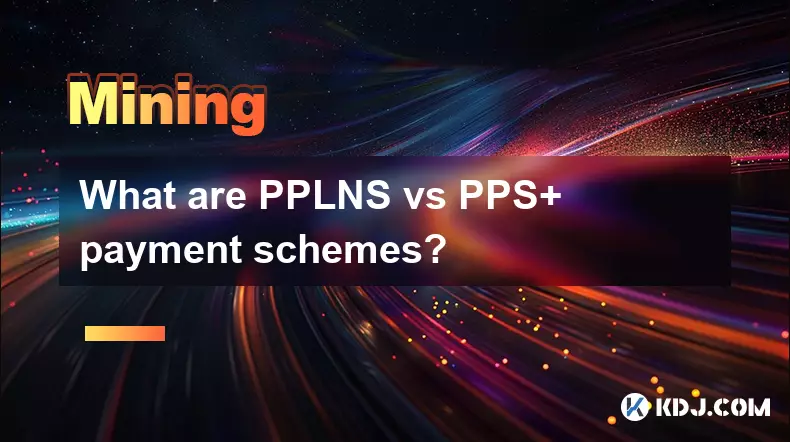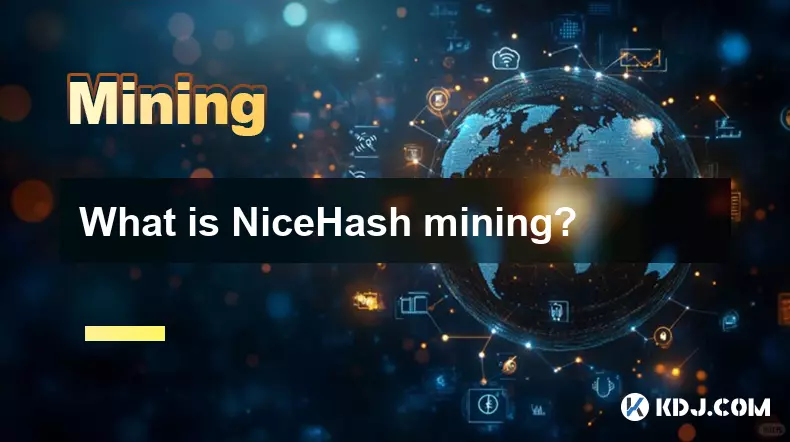-
 bitcoin
bitcoin $100977.009184 USD
-2.05% -
 ethereum
ethereum $3282.009150 USD
-3.23% -
 tether
tether $0.999813 USD
-0.02% -
 xrp
xrp $2.208254 USD
-4.89% -
 bnb
bnb $951.411089 USD
0.55% -
 solana
solana $155.761205 USD
-2.84% -
 usd-coin
usd-coin $1.000217 USD
0.02% -
 tron
tron $0.284475 USD
-1.28% -
 dogecoin
dogecoin $0.162363 USD
-1.53% -
 cardano
cardano $0.533988 USD
-0.47% -
 hyperliquid
hyperliquid $39.174339 USD
-3.22% -
 chainlink
chainlink $14.724828 USD
-1.16% -
 bitcoin-cash
bitcoin-cash $477.297986 USD
-1.28% -
 zcash
zcash $554.227426 USD
17.30% -
 ethena-usde
ethena-usde $0.998995 USD
-0.03%
What are PPLNS vs PPS+ payment schemes?
PPLNS rewards consistent miners with higher long-term payouts, while PPS+ offers stable, immediate earnings per share, ideal for risk-averse miners.
Nov 05, 2025 at 01:55 pm

Understanding PPLNS and PPS+ in Cryptocurrency Mining
1. PPLNS, or Pay Per Last N Shares, is a reward distribution method used in mining pools where miners are paid based on the number of valid shares they submit over a rolling window of the last N shares. This system emphasizes recent contribution rather than overall network uptime. Miners receive payouts only when a block is successfully mined by the pool, and their share within that block’s reward depends on how many of the most recent shares they contributed.
2. Under PPLNS, consistency and long-term participation offer advantages. A miner who stays connected during both successful and unsuccessful mining periods builds a stronger claim when a block is found. Because the payout relies on historical share data, short bursts of mining activity yield lower returns unless timed precisely around block discovery.
3. In contrast, PPS+, or Pay Per Share Plus, offers immediate and predictable rewards. Miners are compensated for every valid share they submit, regardless of whether the pool finds a block. The “Plus” component includes not just block rewards but also transaction fees and sometimes additional blockchain incentives, all factored into the share-based payment rate.
4. PPS+ reduces variance significantly. Since payments occur per share, miners receive steady income proportional to their hashrate. This model shifts the risk of block-finding variance from the miner to the pool operator, who must cover potential losses during dry spells. As such, pools using PPS+ often charge higher fees or require more robust financial backing.
5. Both systems aim to balance fairness and sustainability but cater to different miner preferences. PPLNS appeals to those with stable setups willing to accept fluctuating payouts for potentially higher long-term gains. PPS+ attracts users seeking reliability, especially smaller miners who cannot absorb the financial impact of high variance.
Risk and Reward Distribution Models
1. In PPLNS, reward variance is directly tied to pool luck and individual timing. If a miner disconnects before a block is found, their accumulated shares may fall outside the “last N” window, resulting in no payout despite effort. Conversely, staying online through low-luck periods can lead to outsized rewards when blocks finally emerge.
2. PPS+ eliminates most of this uncertainty by guaranteeing payment per share. The pool estimates the value of each share based on difficulty and average block rewards, then pays miners immediately. This creates a smoother income stream, critical for commercial mining operations needing predictable cash flow.
3. Pool operators using PPS+ assume greater financial liability. They must have reserves to pay miners even during extended periods without block discoveries. To offset this, they typically deduct larger fees—sometimes 2% to 4%—compared to PPLNS pools that might charge only 1% to 2%.
4. Transaction fee inclusion differs between models. In PPS+, fees are usually incorporated into the base share value, meaning miners benefit automatically. In PPLNS, the total block reward—including fees—is divided among participants in the active share window, so large transactions can boost payouts unexpectedly.
5. Network congestion and mempool dynamics indirectly influence both schemes. High transaction fees increase the value of each block, amplifying PPLNS windfalls and raising the cost burden on PPS+ operators. These external factors make real-time adjustment of share pricing essential in PPS+ environments.
Miner Strategy and Pool Selection
1. Miners evaluating payment schemes must consider hardware efficiency, uptime reliability, and risk tolerance. Those with intermittent connectivity or unstable power may favor PPS+ to avoid losing contributions due to disconnection gaps.
2. Large-scale mining farms often lean toward PPLNS when operating in regions with stable infrastructure. Their continuous operation maximizes presence in the share window, increasing the likelihood of capturing full block rewards over time.
p>3. Pool hopping, the practice of switching pools temporarily during favorable conditions, impacts PPLNS more than PPS+. Since PPLNS rewards depend on sustained contribution, short-term entrants dilute their own returns and disrupt fairness. Some pools implement countermeasures like score-based weighting to discourage hopping.
4. Transparency in share tracking and payout calculation is crucial. Reputable pools provide dashboards showing share counts, estimated earnings, and historical payouts. For PPLNS, visualizing the current share window helps miners understand their position relative to block discoveries.
5. Fee structures should be analyzed alongside payment methods. A low-fee PPLNS pool might outperform a high-fee PPS+ option depending on network conditions. Realized profitability requires monitoring actual payouts over weeks, not just theoretical rates.
Frequently Asked Questions
What causes payout delays in PPLNS systems?Payout delays occur because rewards are only distributed after a block is found. If the pool experiences a dry spell, miners continue submitting shares without immediate compensation. Once a block is mined, all eligible shares within the defined window are settled at once, creating irregular payment intervals.
How do pools calculate the value of a share in PPS+?The value is derived from the blockchain’s block reward, average transaction fees, and network difficulty. Each share is assigned an expected value based on the probability of contributing to a block. Operators update this rate frequently to reflect changing conditions and maintain solvency.
Can a miner earn more under PPLNS than PPS+?Yes, during periods of above-average pool luck, PPLNS miners can receive payouts exceeding what they would have earned under PPS+. However, during unlucky stretches, earnings drop below PPS+ levels. Over extended periods and neutral luck, well-run PPLNS pools may offer slightly higher net returns due to lower fees.
Do all mining pools offer both PPLNS and PPS+?No, pools typically specialize in one or two models. Some platforms allow miners to choose between variants, but operational complexity limits widespread dual support. Miners must select pools based on preferred payment mechanics and associated trade-offs.
Disclaimer:info@kdj.com
The information provided is not trading advice. kdj.com does not assume any responsibility for any investments made based on the information provided in this article. Cryptocurrencies are highly volatile and it is highly recommended that you invest with caution after thorough research!
If you believe that the content used on this website infringes your copyright, please contact us immediately (info@kdj.com) and we will delete it promptly.
- BlockDAG, Avalanche, Dogecoin: Crypto's Leading Trio in 2025
- 2025-11-07 22:05:01
- Layer 2 Coins: Will There Be a Potential Explosion by 2026?
- 2025-11-07 16:50:02
- Filecoin, ICP, and the AI Infrastructure Renaissance: Is History Repeating?
- 2025-11-07 16:50:02
- Bitcoin's Wild Ride: Surges, Zeros, and the Search for Stability
- 2025-11-07 17:05:01
- XRP, Bitcoin, and the Rally: What's the Deal, New York?
- 2025-11-07 17:25:01
- Filecoin, DePIN, and a Technical Breakout: What's the Buzz?
- 2025-11-07 17:05:01
Related knowledge

What is the block reward in mining?
Nov 06,2025 at 12:35am
Understanding Block Rewards in Cryptocurrency Mining1. The block reward is the incentive miners receive for successfully validating and adding a new b...

How do mining algorithms work?
Nov 06,2025 at 04:59am
Mining Algorithms and Their Role in Blockchain Networks1. Mining algorithms serve as the backbone of blockchain consensus mechanisms, ensuring that tr...

What is NiceHash mining?
Nov 06,2025 at 07:40am
NiceHash mining refers to the process of renting out computational power to individuals or organizations seeking to mine cryptocurrencies without owni...

Does an antivirus program affect mining?
Nov 05,2025 at 09:29pm
Understanding Decentralized Exchanges in the Crypto Ecosystem1. Decentralized exchanges (DEXs) operate without a central authority, allowing users to ...

What is the history of Bitcoin mining?
Nov 05,2025 at 08:15pm
Within the fast-moving world of cryptocurrency, new developments emerge daily, reshaping how investors, developers, and institutions interact with dig...

How is the energy consumption of mining justified?
Nov 05,2025 at 10:20pm
Energy Consumption in Cryptocurrency Mining1. The energy consumption associated with cryptocurrency mining has drawn significant attention from enviro...

What is the block reward in mining?
Nov 06,2025 at 12:35am
Understanding Block Rewards in Cryptocurrency Mining1. The block reward is the incentive miners receive for successfully validating and adding a new b...

How do mining algorithms work?
Nov 06,2025 at 04:59am
Mining Algorithms and Their Role in Blockchain Networks1. Mining algorithms serve as the backbone of blockchain consensus mechanisms, ensuring that tr...

What is NiceHash mining?
Nov 06,2025 at 07:40am
NiceHash mining refers to the process of renting out computational power to individuals or organizations seeking to mine cryptocurrencies without owni...

Does an antivirus program affect mining?
Nov 05,2025 at 09:29pm
Understanding Decentralized Exchanges in the Crypto Ecosystem1. Decentralized exchanges (DEXs) operate without a central authority, allowing users to ...

What is the history of Bitcoin mining?
Nov 05,2025 at 08:15pm
Within the fast-moving world of cryptocurrency, new developments emerge daily, reshaping how investors, developers, and institutions interact with dig...

How is the energy consumption of mining justified?
Nov 05,2025 at 10:20pm
Energy Consumption in Cryptocurrency Mining1. The energy consumption associated with cryptocurrency mining has drawn significant attention from enviro...
See all articles





















![The Graph Price Prediction [GRT Crypto Price News Today] The Graph Price Prediction [GRT Crypto Price News Today]](/uploads/2025/11/07/cryptocurrencies-news/videos/690d4df44fe69_image_500_375.webp)




















































